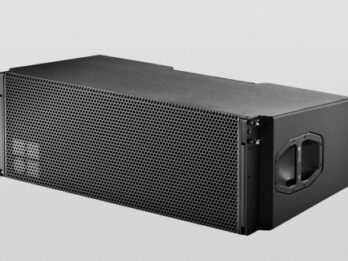J-Series @ Milwall
A family day out for twelve thousand at Millwall football ground, an unlikely setting you might say, but Millwall has travelled a long way from its dreadful reputation of the eighties. Focussed on the day of Pentecost, Global Day of Prayer, celebrated at Millwall and simultaneously at many other venues throughout the world, is an apt demonstration of what can be achieved with a proper sense of community and belief.
Conducting the style of religious celebration typical of these large Christian events is also not without its challenges. The GDOP at Millwall ran for four and half hours, featured a choir of five hundred adult and two hundred children’s voices, singing against a musical backdrop provided by a thirty piece conventional orchestra and six piece electric contemporary band.
Andy Barr from Pure Solutions provided the production expertise for GDOP, engaging the very able services of Reading based SFL Group to supply sound, lighting and video expertise. “It’s the second such event we’ve done for GDOP,” said SFL’s MD Mark Payne. “Last year it was staged at West Ham’s ground; the shift this year to be accessible to different parts of the community. We provide a full stage lighting system; the front end video PPU, cameras and mixing; and a comprehensive audio system.”
With such a large and dynamically varied range of performers the audio side appears a big job to manage? “There are two main factors to contend with, the performers you already know about, though I would add there were also three solo vocalists, nine backing singers, three Worship leaders and a full orchestra plus the high energy contribution from the Psalm Drummers, an astonishing group of thirty percussionists. The second is the audience. Coverage and intelligibility are paramount for obvious reasons, and levels across the full audio spectrum need to be sustained at even and comfortable levels. And that doesn’t mean quiet; excitement is an important factor, but we’re not here to exhaust, rather to delight.”
Of note on stage was Payne’s use of DPA Millennium Bug mics for the string section; “These produce a really fresh vibrant sound and you can really capture the life of the strings. The field is a hundred metres long; we rigged two eleven metre tall tepees from which we suspended d&b audiotechnik J-Series J8 line array loudspeakers, with two of the wide angle J12 cabinets at the bottom of each hang. The only areas these couldn’t cover were the extreme sides of stage into the stands. Here we ground stacked the more compact d&b Q-Series loudspeakers, curved upwards, which worked exceedingly well. With no public access within five metres of the stack, this enabled the correct application of power to reach the topmost seats without blasting the people sitting closest. Across the front of stage we also placed three cardioid J subwoofers per side, to relieve the orchestra from having to hear the low end on stage; these also had Q10s on top of them for front fills.”
“With the main system J loudspeakers toed out 10° this gave me perfect coverage across the pitch and stands to seventy four metres from stage, well behind the mix position. There was of course slight decoupling of the main system in the middle ground, but the J12s covered that area perfectly. At the seventy four metre point I chose to rig delays to cover the rear and side stands, again Q-Series loudspeakers ground stacked; this time on top of cardioid stacked Q subwoofers.”
Payne mixed using a pair of Yamaha M7CLs front of house (PM5D for monitors with d&b MAX wedges). “This was a ninety six input show and I ran the whole output system digitally in AES/EBU to the d&b D12 and D6 amplifiers to minimise the number of AD/DA conversions. Because of the distance limitations of AES/EBU over standard balanced lines we ran into Neutrik impedance conversion transformers enabling us to run the signal over 75Ohm video coax cable still in digital form over one hundred metres all the way to the various amplifier locations where it was converted back to 110 ohm AES/EBU before going into the amplifier system. All the D12 amplifiers were positioned local to their relevant stacks and linked by CAN-Bus driven by the new d&b R70 interface that enables long distance remote control over Ethernet, a system that performed absolutely as expected. With the d&b R1 Remote control software and a wireless station FoH, I was able to access all parts of the system and my desks from my laptop anywhere in the stadium for EQ and delay settings.”
This event is featured on the d&b website HERE.
Gallery





J8 – Product focus
The J8 is a 3-way design housing 2 x 12″ LF drivers, one hornloaded 10″ MF driver and two 1.4″ exit HF compression drivers with 3″ voicecoils mounted to a dedicated waveshaping device. The mechanical and acoustical design enables flown vertical columns of up to 24 loudspeakers to be suspended using vertical splay angles between them of 0° to 7° with a 1° resolution. The cylindrical wave segments produced couple coherently in the vertical plane. Due to the dipolar arrangement of the neodymium LF drivers the exceptional 80° horizontal constant directivity dispersion control is nominally maintained down to 250 Hz. The J8 is acoustically and mechanically compatible with the J12 loudspeaker. It can be used in columns of purely J8 loudspeakers or combined with J12s and / or with J-SUBs.
